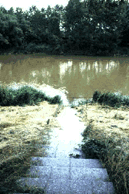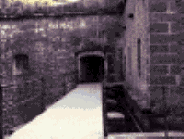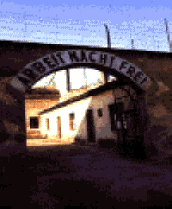|
|
|
|
Terezin |
Map of Concentration/Death Camps |
| Before Theresienstadt got its name it was called Terezin. Terezin is a town located 90 miles north of Prague, and south of Litomerice. The town was originally built in 1780 by Emperor Joseph II and was named after his mother Empress Maria Teresa. Terezin changed dramatically when the Nazis changed it's name to Theresienstadt. | |
|
Theresienstadt |
|
| Theresienstadt was a ghetto in Czechoslovakia run by the SS. The ghetto was used for propaganda purposes trying to show the world that this ghetto was a special place with happy and healthy Jews. But it was nothing like that. | |
| Many Jews especially the elderly were told by the Nazis that they were going to a resort or spa. Many paid large sums of money for their new home.. The only space provided to each Jew at their "new home" was only 2 square yards. The living and sleeping space was covered with vermin. Rats, fleas, lice, and flies were everywhere. Al the food was rationed-men who worked hardest were given the most, and the elderly were given the least. For some of these reasons the Red Cross would visit. | |
|
The Red Cross |
|
| The Red Cross visited Theresienstadt but were shown places that were not occupied by Jewish prisoners. They were shown stores, cafes, and schools. Jewish inmates were under guard and ordered to 'stroll' around the place. A favorable report was given afterwards. | |
| All of the actions were well rehearsed when the Red Cross visited. Bakers were baking bread, and fresh vegetables were delivered. In October of 1943 the Danish and Swedish Red Cross began asking about the Danish Jews, and their conditions. The Nazis then covered up the overcrowding, infested, malnourished, and inhumane conditions. | |
|
Colonel Karl Rahm |
|
| Colonel Karl Rahm controlled the plans to clean up and change Theresienstadt prior to the Red Cross visit. Only one route was to be taken. All the buildings and grounds on this route were changed. Green grass, flowers, benches, playgrounds, and sports fields were added. Rahm thought that the ghetto was too crowded. He ordered 7500 Jews to be deported. They decided that the sick and the orphans should be the first to go. Now he was prepared for when the Red Cross came. | |
|
Deaths and Deportations Deportations: 100-500 Jews were deported daily. The burden of who was to be deported was placed on the Jews. Some ways that helped Jews from being deported were jobs that helped the German war effort, important workers in the ghetto, or being on someone else's list. Finding ways to keep from being deported to extermination camps became a major endeavor for each ghetto inhabitant. Deaths: 33,000 Jews died, 88,000 were deported to extermination camps. 15,000 children were at the camp, only 100 survived. Due to the large number of deaths a crematorium was built, which disposed of 190 corpses a day.When liberating troops were nearly upon Theresienstadt, the Nazis and their collaborators panicked. Fearing discovery of their heinous crimes against humanity, the Nazis ordered the surviving inmates to scrape up the human ashes and dump them into the nearby Ohre River. Now the river is clouded, unlike before when it was clear.
The Ohre River |
|
|
Epidemics |
|
|
Due
to the poor conditions at the ghetto, epidemics took many Jewish
lives. Many more Jewish prisoners arrived at the camp, and many
more epidemics broke out. Transport and death marches reached
Theresienstadt. These groups were being evacuated from
concentration camps such as Auschwitz and Ravensbruck. They were
all in terrible health and carried typhus. Besides typhus the
prisoners brought the truth about the east transports. The truth
being far worse than the rumors.
Only 400 Jews were left at the end of the war. The Nazis did not know what to do with the remaining inhabitants. Some of the Nazis still wanted to cover up the inhumane conditions and treatment of the Jews hoping not to be convicted of war crimes. Others wanted to dispose of the remaining Jews. No decision was ever made but some of the Jews were transported to Switzerland. |
|
|
Before Theresienstadt |
|
|
The town Terezin originally had room for only 7,000 residents. The
concentration camp added about 35,000-60,000 people. There was
lack of housing, bathrooms were scarce, the water was limited and
contaminated, and it lacked sufficient electricity.
Terezin consisted of the Big Fortress and the Small Fortress. But after 1882 the town was no longer used as a fortress. The Big Fortress was surrounded by ramparts and contained barracks.The Small Fortress became a prison for dangerous criminals. |
The Small Fortress |
|
Terezin Today |
|
|
When visit Terezin today they are able to visit a newly created museum
holding original children's art and poems along with the works of the
adults. Artifacts of the everyday life at the
ghetto/concentration camp are well displayed along with original Nazi
documents, maps, and other information.
When prisoners entered the ghetto they would pass through an archway that said with the Nazi rune, 'Work Makes One Free.' This archway still stands and the saying still remains.
|
Theresienstadt Ghetto Entry |




